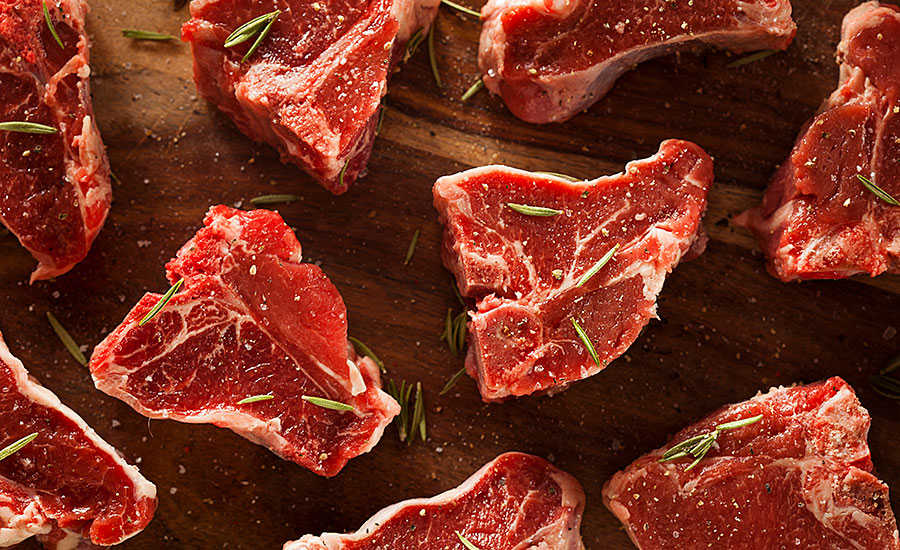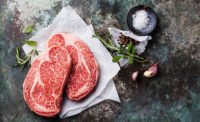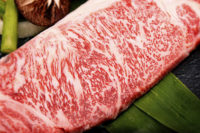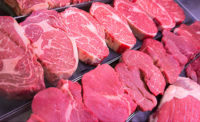Meat Science Review
Effects of marbling, postmortem aging lamb loin

The objective of this study was to evaluate the effects of marbling category and postmortem aging on the palatability of lamb loin chops as determined by U.S. consumers. Additionally, our secondary objective was to determine the relationship between marbling, flank streaking, intramuscular fat percentage (IMF), and the palatability traits of tenderness, juiciness, flavor liking, and overall liking.
Carcasses (n=180; 60/treatment) were selected at a commercial lamb processor in Greeley, Colo., with initial marbling score and flank streaking (200 = traces00, 300 = slight00, 400 = small00, 500 = modest00, 600 = moderate00, 700 = slightly abundant00) being determined within seconds of carcass ribbing because carcasses immediately (in less than one minute’s time) entered the fabrication room after ribbing. Full lamb loins (IMPS 232; 1 × 1in) representing the three targeted marbling levels [LOW, Medium (MED), HIGH] were obtained based on initial marbling score, vacuum packaged, shipped to Texas Tech University, and stored under refrigeration (2-4°C) until fabrication. On Day 21 postmortem, loins were removed from packaging, and marbling score was assessed following a 10-minute bloom period to ensure marbling was classified correctly during the initial plant assessment. Lamb loins had the following 21-day marbling score ranges: LOW = slight00- slight90, MED = small00- modest20, HIGH = modest50- slightly abundant40. Loins were fabricated, leaving only the longissimus muscle, then manually sliced into 2.5-cm thick chops. Chops were vacuum-packaged individually and either frozen immediately at minus-20ºC, or stored at 2ºC until 42 days postmortem, then frozen. After thawing for sensory testing, chops were cooked on a clamshell grill utilizing a time schedule with a 3-minute cook period to target medium degree of doneness (71°C) followed by a 45-second rest period before serving.
Untrained consumers (n=360) rated tenderness, juiciness, flavor liking and overall liking on 100-mm line scales. Samples were fed in a predetermined and balanced order to consumers so each consumer could evaluate all six test samples representing the different treatments. Consumers also selected an overall eating quality category for each sample.
Based on previous research in pork and beef, we expected consumers would favor lamb loins with higher marbling levels and longer aging, resulting in higher scores for tenderness, juiciness, flavor and overall liking. Marbling and aging did not interact to affect any of the scores for palatability attributes or the frequency of their overall eating quality classifications (P < 0.05). Consumers rated HIGH treatments (P < 0.05) as more tender, juicier, and with greater flavor liking and overall liking than MED or LOW, which were similar for all traits (P > 0.05). This result was not surprising given the magnitude of the difference in IMF percentage between MED and LOW was less than the difference between HIGH and MED. Aging also influenced (P < 0.05) all traits, as consumers scored 21-day samples greater for all palatability traits than their 42-day counterparts. Our findings could suggest the substantial reduction in flavor liking scores associated with extended aging to 42 days may have carried over to cause a decrease in tenderness, juiciness and overall liking scores for 42-day samples compared to their 21-day counterparts. Further investigation is warranted to understand why flavor liking scores were reduced with additional postmortem aging, but it is possible cutting loins and aging as chops the final 21 days influenced flavor liking. Although samples were always maintained at 2-4ºC during processing and postmortem storage, lowering the temperature of chilled storage could also potentially influence flavor liking. A greater (P < 0.05) percentage of consumers categorized 42-day samples as “unsatisfactory” and fewer as “better than everyday quality” or “premium quality” than 21-day samples. A larger proportion of consumers categorized HIGH samples as “premium quality” than MED or LOW and fewer called HIGH “good everyday quality” compared to MED (P < 0.05).
Flank streaking (FS), 21-day marbling scores (21dMB), and IMF% were all influenced (P < 0.01) by target marbling level in a linear fashion. As expected, HIGH had the highest values (FS:Mt54, 21dMB: Md09 and 6.2% IMF), MED were intermediate (FS:Sm71, 21dMB: Sm56 and 4.4% IMF), and LOW had the lowest values (FS:Sl53, 21dMB: Sl41 and 3.7% IMF). With flank streaking being commonly used to evaluate lamb quality, a strong positive correlation would be expected with marbling level and IMF.
Within the eating quality traits, flavor liking was most strongly correlated (r=0.93; P<0.01) to overall liking, followed by juiciness (r=0.63) and tenderness (r=0.62). There were strong relationships (P<0.01) between 21dMB and IMF (r=0.70), as well as between FS with 21dMB and IMF (r=0.60, 0.44, respectively). When examining the relationships between FS with the palatability traits, only juiciness had a correlation (r=0.07; P<0.01) with FS. Marbling at 21 days was correlated (P<0.01) with tenderness, juiciness, flavor liking and overall liking, (r=0.09, 0.13, 0.09, and 0.09, respectively). However, IMF was only related (P<0.01) to tenderness (r=0.08) and juiciness (r=0.09).
Despite half (50.6%) of the consumers having never eaten lamb, the results clearly show that the lamb product is highly rated by U.S. consumers. Tenderness, juiciness and flavor liking were major drivers for consumer sensory scores for overall liking, with flavor liking having the biggest impact on overall liking of lamb. Increasing marbling score, more so than flank streaking, was positively linked to increasing eating quality scores. Overall, results from the study showed that consumers preferred lamb with the highest level of marbling to prompt greater palatability scores than LOW or MED marbling. Consumers also had difficulty distinguishing between LOW and MED.
Extending aging of domestic lamb from 21 to 42 days appeared to be detrimental to consumer liking of lamb loins, regardless of marbling level, and is not recommended based on reduced scores for eating quality traits, particularly flavor liking. NP
Looking for a reprint of this article?
From high-res PDFs to custom plaques, order your copy today!





